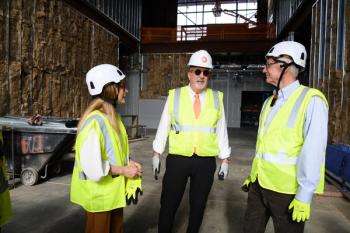
It's almost 2016! Buy that thing!
or, better yet, do a little bit of basic math and figure out whether that rad, new veterinary doohickey (and the potential end-of-the-year tax break) is worth it.
An associate demonstrates the power of a calculator. (Getty Images)Hey, folks.
If you're a veterinary practice management power user, you can probably skip this.
But if you could use the world's easiest refresher on financing math to figure out return on investment (ROI, folks) and how long it'll take to pay off a new piece of equipment at your veterinary hospital, step right up. We've got the details from veterinary practice accountant Gary Glassman, CPA, partner with Burzenski & Co. in East Haven, Connecticut. Here we go ...
“How long will it take to pay off the machine?”
A good goal is three to five years on equipment more likely to become obsolete (you're replacing your film radiography with another film system?!) and five to seven years on other equipment (like Ye Olde anesthesia machine). Now plug in numbers!
Formula No. 1
$ __________ Total cost of equipment*
÷
$ __________ Annual cash flow from equipment**
=
__________ years to pay off
* Don't forget to include cost of setup, team and/or doctor training and shipping, especially on hefty items.
** That's gross revenue of the procedures minus your loan payment and loan interest, necessary supplies, usual maintenance, insurance, labor cost and any doctors' production-based pay.
Sample Formula No. 1
$37,000 Total cost ÷ $7,500 Annual cash flow = 4.9 years
If you wind up with too many years (more than five for equipment likely to become obsolete and more than seven for more evergreen machines), you need to cut the equipment cost or increase the cash flow.
“What's my return on investment?”
Your goal should not be just to break even. A veterinary practice is a business and needs growth. Aim for 20 percent or more.
Formula No. 2
$ __________ Annual cash flow from equipment
÷
$ __________ Total cost of equipment
=
__________ % Return on investment
Sample Formula No. 2
$7,500 Annual cash flow ÷ $37,000 Total cost = 20%
“Performing the above computations will assure the practice a winning benefit to both the client and the hospital,” Glassman says.
In other words, a few minutes of perusing your records and the two formulas above can save you from that frustrated feeling you get every time you look at that totally awesome, really cutting-edge veterinary thingamajig you never learned to use and couldn't recommend to clients.
Newsletter
From exam room tips to practice management insights, get trusted veterinary news delivered straight to your inbox—subscribe to dvm360.




